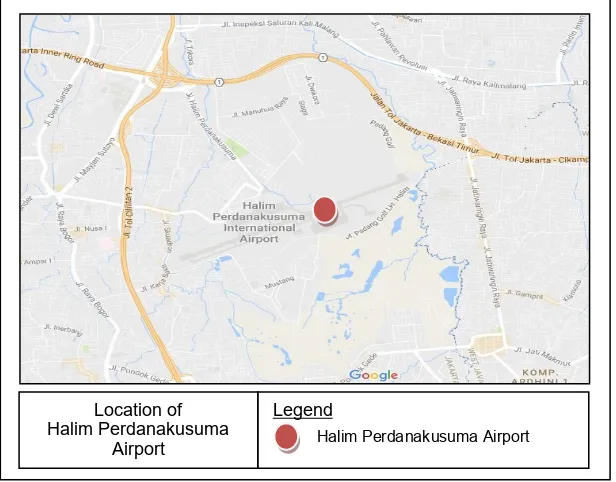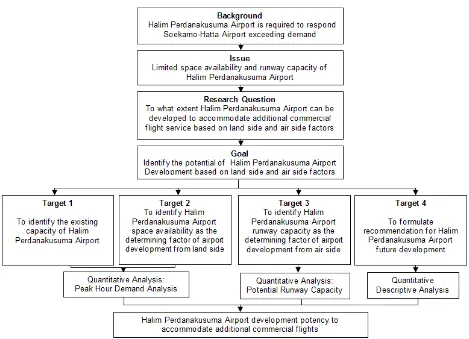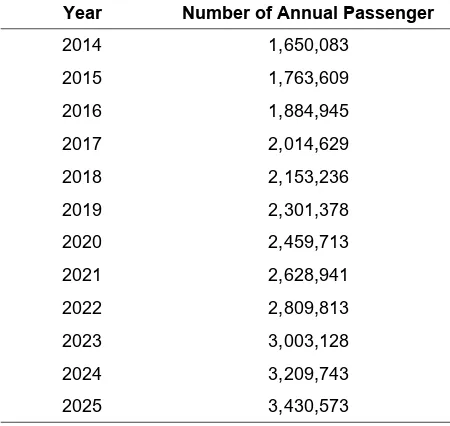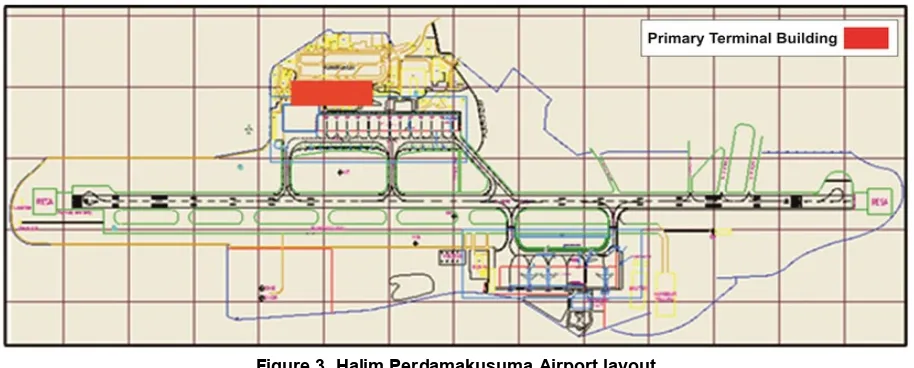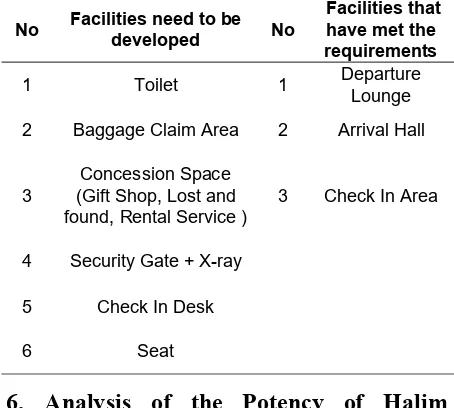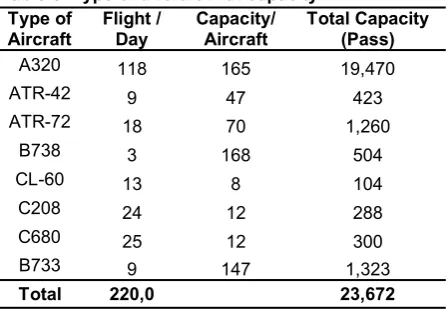The Potency of Halim Perdanakusuma Airport Development
as Commercial Airport
Miming Miharja
Kelompok Keahlian Sistem Infrastruktur Wilayah dan Kota, SAPPK ITB, Gedung Labtek IX-A Jl. Ganesha No. 10 Bandung 40132, E-mail: [email protected]
Dwitami Puspaningrum
Program Studi Perencanaan Wilayah dan Kota, SAPPK ITB, Gedung Labtek IX-A Jl. Ganesha No. 10 Bandung 40132, E-mail: [email protected]
Jurnal Teoretis dan Terapan Bidang Rekayasa Sipil Jurnal Teoretis dan Terapan Bidang Rekayasa Sipil
Abstract
Nowadays, Halim Perdanakusuma Airport plays a role in facilitating commercial and military flight activities. In the commercial flight segment, the role of Halim Perdanakusuma airport is expected to reduce the load of Soekarno-Hatta International Airport in serving the ever increasing flight volume. As part of this concern, this
article analyzes the potency of Halim Perdanakusuma Aiport to respond the growing demand of commercial flight based on land side and air side development potential factors. The potency of development from land side is based on the space availability to meet the standard of passenger service facilities, whereas the air side is based on the airport runway capacity in accommodating the number of aircraft take-off and landing activities according to their
types as well as loading capacities. The need for airport development is based on the standard of space needs for each passenger during the peak time. Analysis result shows that the most critical constraint is coming from land side due to space limitation for the development of various facilities required to fulfil the service standard, which available only for up to 2,750,369 total passengers per year. Meanwhile, there is no significant constraint for airport development from the air side point of view.
Keywords:Airport development, commercial airport, land side, air side.
Abstrak
Saat ini, Bandara Halim Perdanakusuma berperan dalam memfasilitasi kegiatan penerbangan komersil dan militer. Pada segmen penerbangan komersial, peran Bandara Halim Perdanakusuma diharapkan dapat mengurangi beban Bandara Internasional Soekarno-Hatta dalam melayani volume penerbangan komersial yang
semakin meningkat. Fokus tulisan ini adalah menganalisis potensi Bandara Halim Perdanakusuma dalam merespon tumbuhnya permintaan dari penerbangan komersial berdasarkan faktor-faktor potensi pengembangan
sisi darat dan sisi udara. Potensi pengembanga dari sisi darat didasarkan pada ketersediaan ruang untuk memenuhi standar fasilitas pelayanan penumpang, sedangkan dari sisi udara berdasarkan pada potensi pengembangan kapasitas landasan pacu bandara dalam melayani aktifitas take-off dan pendaratan pesawat sesuai
dengan jenis dan kapasitas angkutnya. Kebutuhan untuk pengembangan bandar udara didasarkan pada standar kebutuhan ruang untuk penumpang pada waktu puncak. Hasil analisis menunjukkan bahwa kendala pengembangan bandara terutama datang dari sisi darat yang disebabkan oleh keterbatasan ruang bagi pengembangan berbagai fasilitas yang diperlukan untuk memenuhi standar pelayanan, yang hanya tersedia untuk melayani 2.750.369 total penumpang per tahun. Sementara itu, tidak terdapat kendala yang signikan untuk pengembangan bandara dari sisi udara.
Kata-kata Kunci: Pengembangan bandara, bandara komersial, sisi darat, sisi udara.
1. Introduction
The existence of an airport is an important element in the provision of air transportation in Indonesia with its geographical condition as an archipelago country. As the main and the largest airport in Indonesia, the Soekarno Hatta airport has carried quite large burden of services. Initially, the Soekarno Hatta Airport was designed to accommodate 22 million passengers annually, but nowadays it has acommodated more than 50 million passengers annually (PT Angkasa Pura II Persero, 2015). This phenomenon led the government to make a decision to reopen Halim Perdanakusuma Airport as a commercial airport to reduce Soekarno
Hatta Airport passengers by 10-12%. Therefore, based on Minister of Transportation Decree No. 369 Year 2013, Halim Perdanakusuma Airport officially operated as commercial airport on 10 January 2014.
Yogyakarta, Jayapura, Palembang, Padang, Medan, Balikpapan, Kupang, Bengkulu, Semarang, Denpasar, Dumai, Cilacap, and Pangandaran. Some commercial flight operators are Airfast, Batik Air, Citilink, Susi Air, Trans Nusa, Pelita Air, dan Travira Air.
According to PT Angkasa Pura II, the commercial flights composition are 73.9% domestic flight and 14.63% international flights, while the composition of the passengers are 93.68% domestic passengers and 6.32% international passengers.
Since Halim Perdanakusuma Airport was officially opened as commercial airport, the number of passengers flew from and to this airport has been growing. As a consequence, all flight supporting facilities should be developed to accommodate the increase of passengers. Therefore, a study is needed to analyze the potency of Halim Perdanakusuma Airport development to accommodate the increase in commercial flight activities. During the analysis, two sides should be taken into consideration, i.e. land side (passenger terminal) and air side (runway capacity). So, the objective of this article is: 1. To identify the existing capacity of Halim
Perdanakusuma Airport passenger terminal. 2. To identify space potency in developing the land
side of the Halim Perdanakusuma airport. 3. To identify the air side capability based on airport
runway capacity in accommodating the number of passengers.
4. To formulate development recommendation that can be done to passenger terminal to accommodate commercial flights at Halim Perdanakusuma Airport.
2. Methodology
The methodology used in this article is quantitative descriptive approach. This approach is used to analyze the conformity between the potency of the capability in providing facilities based on the existing minimum needs standard and to do descriptive analysis on airport development that can be done by the Halim Perdanakusuma Airport.
2.1 Data collection method
Data collection was conducted through literature study, observation, and secondary data collection. Literature study was conducted by studying references on standards of space needs for airport and planning standard of airport terminal. The literature study was also conducted toward the previous research that would be used to analyze the third objective that is to develop the airport from the air side. Observation and secondary data collection were conducted to figure out the existing condition of Halim Perdanakusuma Airport in serving passengers as commercial airport. Most of the secondary data was obtained from PT Angkasa Pura II (Persero), Halim Perdanakusuma branch.
2.2 Data analysis method
The method of descriptive quantitative analysis was used to see the conformity of the existing condition of the airport with the minimum needs standard of an airport. The standard was obtained through literature review using national and international standard. The national standard used in this article is Peraturan Direktur Jenderal Perhubungan Udara No: SKEP 77/ VI/2005 on Technical Requirements of the Operational of Airport Technical Facilities, and SNI 03-7046-2004 on Airport Passenger Terminal. The standards international
Figure 1. Location of Halim Perdanakusuma Airport
Source : Google Maps (2017) Legend
Location of Halim Perdanakusuma
used were from International Civil Aviation Organization (1987), International Air Transport Association (2004), Federal Aviation Administration (1988), Airport Cooperative Research Program (2010, 2011, 2015), and Horonjeff, et al. (2010). From those standards, an adjustment was conducted to the use of the standards based on the airport existing condition.
Supply and demand analysis was conducted to figure out the gap between airport capacity and service demand that is derived from the number of passenger per current unit of time.Then, analysis conducted in this article also used Peak Hour Demand Analysis Method. This method was used to figure out the demand produced from the number of passenger during peak hour. This demand analysis during peak hour is important for the planning of airport capacity development capable of serving the needs during the highest demand volume, for instance during the holiday seasons and religious events.
Furthermore, descriptive analysis was conducted to analyze the potency of airport development that can be done by looking at the space that can be developed at the airport at the land side. In the mean time, the analysis of the potency from the air side was conducted using literature study from previous research with data on the flight frequency that can be facilitated by the Halim Perdanakusuma Airport runway. The data was then re-analyzed using the capacity requirement of each aircraft that can operate at the Halim Perdanakusuma
Airport to obtain the number of passenger that can be accommodated by the existing capacity of Halim Perdanakusuma Airport runway.
3. Projection of Passenger Growth at Halim
Perdanakusuma Airport
One of the objectives with the opening of Halim Perdanakusuma Airport as commercial airport is to accommodate passenger runoff of the Soekarno Hatta Airport to Halim Airport. Another factor that will have an effect on the projection of Halim Perdanakusuma airport passengers is the construction of new airports such as West Java International Airport and Pondok Cabe Airport that will be operated as new commercial airports. This will have an effect on the future number of Halim Airport passenger. However, this study considered that flights facilitated by other airports only served unique flight rules and is different from flight routes from Halim Perdanakusuma Airport. Therefore, this article used an assumption that the developmwent of this airport was only affected by internal factors of the Halim Perdanakusuma Airport.
The estimation of passenger growth at Halim Perdanakusuma Airport was done by extrapolating data of Halim Perdanakusuma Airport passenger when the airpor had become commercial airport. However, since the airport became commercial in 2014, the data available was 2014 data. For the sake of projection, the rate of Halim Perdanakusuma Airport passenger growth
was approximated with the rate of Soekarno Hatta Airport passenger growth at the domestic flight since Soekarno Hatta Airport is assumed to have similar characteristic with Halim Perdanakusuma Airport, that is both airports are in the same region, which is assumed to have similar socio-economic characters of inhabitants. This socio-economic similarity is assumed to imply relatively similar demand rate for both domestic and international flights. Therefore, passenger growth at Halim Perdanakusuma Airport and Soekarno Hatta are assumed to have similar characteristic.
Table 1 shows passenger growth at Soekarno Hatta Airport that will be used to estimate the number of passengger at Halim Perdanakusuma Airport.
Based on Table 1, the rate of passenger growth at the Soekarno-Hatta Airport is 6.88%. Next, the number was used as the rate of Halim Perdanakusuma Airport passenger growth for the projection of the future number of passenger. The following is the the table of extrapolation of the number of Halim Perdanakusuma passenger using 6.88% as the rate of passenger growth.
The result of Halim Perdanakusuma Airport passenger projection until 2025 can be seen on Table 2.
4. Number of Passenger during Peak Hour
Determining the number of passenger during peak hour is needed for calculation analysis of the standard minimum of the airport passenger facilities provision based on the existing standard. The provision of all airport facilities should be able to accommodate all facilities when the number of passenger is at the highest or also called during peak hour. Therefore, the number of passenger during peak hour should be determined to fulfill the needs of airport passenger facilities.The method of determining the number of passenger during peak hour was conducted using data of annual number of passenger that was processed using TPHP (Typical Peak Hour Passenger) method. This method produced an estimation of the number of passenger during peak hour that should be served by the airport. Ashford, et al. (2011) stated that the projection of the number of passenger during peak hour can be done using the percentage of the number of annual airport passenger. The following is the category of percentage of the number of passenger during peak hour Vis a Vis annual airport passenger.
The number of Halim Perdanakusuma Airport annual passenger is 1,650,083 with 822,516 arriving passengers and 827,567 departing passengers. Therefore, Halim Perdanakusuma Airport is in the 4th category, i.e. the percentage of TPHP that is used to determine the number of passenger during peak hour is 0.05%.
Therefore, the number of passenger during peak hour
(Penumpang Waktu Sibuk=PWS) of Halim Perdanakusuma Airport is:
PWS = 0.05% x 1,650,083 = 825 PWS
This number of passenger during peak hour is also divided into PWS Arrival and PWS Departure.
PWS Arrival= 0.05% x 822,516 = 411 PWS PWS Departure=0.05%x827,567=414 PWS
Table 1. Data of passenger growth at Soekarno Hatta Airport
Year Number of Domestic Annual Growth
2010 31,166,180
Table 2. Estimation of passsenger growth at Halim Perdanakusuma Airport
Table 3. Percentage of typical peak hour passenger
No Number of Annual TPHP Percentage
5. Analysis of the Existing Capacity of
Halim Perdanakusuma Airport
The analysis of the capacity of airport passenger terminal was conducted to figure out the capability of Halim Perdanakusuma Airport passenger terminal in serving commercial flight. This passenger terminal capacity could be figured out by analyzing the availability of existing spaces in the terminal that were allocated as mandatory facilities of airport passenger terminal. The capacity of airport terminal can be assessed by supply and demand approach. This approach was conducted by comparing the existing faclities with the need of minimum space to accommodate the number of passenger during peak hour based on the standards of space needs that are used.
Based on the data of passenger terminal existing condition, the passenger terminal of Halim Perdanakusuma Airport has an area of 9,630 m2. Based
on the standard of aggregate space needs of airport pasenger terminal, Halim Perdanakusuma Airport can accommodate passengers:
According to Ashfort, et al. (2011), the standard total area of passenger terminal of an airport serving domestic and international flights is 10,000 m2 for 1 million passengers for 1 year (mppa).
Total space area= 9,630 m2
Standard= 10,000 m2 / 1,000,000 passengers = 0.01 m2/passenger annually
Number of passenger = total area/ standard = 9,630 m2 / 0.01 m2/ passenger annually
= 963,000 passengers annually
Therefore, based on its existing capacity, the passenger terminal of Halim Perdanakusuma Airport can accommodate 963,000 passengers annually. Meanwhile, the current number of passenger at the passenger terminal of Halim Perdanakusuma Airport is 1,650,083
passengers annually. So, the space of Halim Perdanakusuma Airport terminal needs to be added
to accommodate the existing number of passenger according the service standard.
In the analysis of Halim Perdanakusuma Airport passenger terminal capacity, the capacity of each mandatory facility in the passenger terminal was elaborated to figure out facilities that should be developed by PT Angkasa Pura II (Persero) to accommodate the number of commercial flight passenger. The following are facilities that affect or are affected by the development of the airport.
From the facilities of airport passengers mentioned above, supply and demand analysis was conducted to figure out the facilities capable of accommodating the existing number of passenger and vice versa, i.e. facilities that are not sufficient to accommodate the existing number of passenger. This supply and demang analysis was conducted by comparing existing availability with the calculation of minimum needs based on the standard of provision in each facility using the unit of passenger at peak hour (PWS).
Based on the calculation using the standard of minimum provision and compared it with the provision in the existing condition, facilities that should be developed could be determined. Then, facilities that are already fulfilled the standard can also be determined. Table 5
shows the facilities that have met the standard and the facilities that needs to be developed.
Table 4. Facilities of airport passenger
Figure 3. Halim Perdamakusuma Airport layout
Source:PT Angkasa Pura II (Persero), Halim Perdanakususma Airport, accesed in March 2016
No Name of Facilities No Name of Facilities
1 Security Gate 8 Arrival Hall
2 X-Ray 9 Check In Area
3 Check In Desk 10 Toilet
4 Departure Lounge 11 Baggage Claim Area
5 Curb Side 12 Concession Space
6 Seats 13 Parking Area
7 Departure Hall 14 Flow+Structure and Utility
6. Analysis of the Potency of Halim
Perdanakusuma Airport Development
Based on Land side
This part analyzes the potency of airport development by looking at the capability from the land side. The chance of airport development should be based on space that can be developed to serve activities of certain number of passengers.
The analysis of the potency of development from the land side assumed that the space available at the airport area can be utilized for the development of service space for commercial flight passengers. Certainly, the utilization of the spaces does not collide with the interest of the Indonesian Air Force in executing its duties and functions.
This development from the land side was conducted by looking at the space available that can still be developed. At Halim Perdanakusuma Airport, development of the land side that can be conducted is only the optimization of office spaces in the airport area, i.e. non military office spaces and airport non -operational.
Total space area that can be developed for airport development is 24,450.8 m2. Out of that total area, the area that can be used for passenger flow (circulation) based on FAA (Federal Aviation Administration) standard in Whitford (2003) is 30%, whereas area to be used for other utilities and building structure is 25% of the total area. Therefore, there is a need to calculate the total land area that will be used to accommodate passenger to figure out total passenger that can be accommodated in the available space.
1. Circulation Space = 30% total area = 30% x 24,450.8 m2 = 7,335.24 m2
2. HVAC Room, mechanic, building structure = 25% x total area= 25% x 24,450.8 m2 = 6,112.7 m2 Therefore, total area that could be developed and used
to accommodate passengers is:
Area = Total area – (Flow area+Utility, Structure) Area = 24,450.8 m2 – (7,335.24 m2 + 6,112.7 m2) = 11,002.86 m2
Based on the standard of minimum space for passenger, the space that should be provided for airport passenger is 10,000 m2 per 1 million passengers annually (Ashford, et al., 2011). Therefore, from additional space of 11,002.86 m2, the airport is capable of accommodating additional passenger of 1,100,286 annually.
Based on the potency of airport land side, the Halim Perdanakusuma airport is capable of accommodating additional passenger of 1,100,286 annually. Therefore, total passenger that can be accommodated by the land side of the airport is:
Current passenger = 1,650,083
The potency of additional passenger = 1,100,286 Total passenger that can be served = 2,750,369 passenger per year.
7. Analysis of the Runway Capacity of
Halim Perdanakusuma Airport
The analysis of runway capacity of this airport was conducted to determine the capacity of total passenger capable of departing and arriving based on the flight frequency at Halim Perdanakusuma Airport.
The analysis of the air side of the Halim Perdanakusuma Airport used flight frequency data that could be done by the Halim Perdanakusuma Airport runway based on previous research conducted by Wibowo and Ramadhan (2015). Based on that research, the Halim Perdanakusuma Airport runway is capable of conducting as many as 17 flights per hour. So, the daily flight frequency could be figured out by multiplying the number of flight operation in an hour with the airport operational duration. Halim Perdanakusuma Airport is in operation for 18.5 hours (05.00 – 23.30). Therefore, flight frequency that can be accommodated by the Halim Perdanakusuma Airport runway is 314.5 flights per day. This number is total flight that can operate at the Halim Perdanakusuma Airport runway. In reality, however, the runway owned by the Halim Perdanakusuma Airport is a sharing runway with the Indonesian Air Force with a comparison of 70% for commercial flight and 30% for military flight. Since this article is to learn the operating commercial flight, then the frequency of commercial flight that can operate at this airport is :
70% x 314.5 flight per day = 220 flights per day From the total of 220 flights per day, the number of passenger conducting flights at Halim Perdanakusuma Airport will be analyzed. The capacity of passenger is calculated by multiplying the number of flight per day with the capacity of each aircraft that can operate and flight frequency at every type of aircraft in operation. The types of commercial aircraft that can operate at Halim Perdanakusuma Airport are: Airbus, Boeing
Table 5. Result of the analysis on the provision of airport passenger facility
No Facilities need to be developed No Facilities that have met the requirements
1 Toilet 1 Departure Lounge
2 Baggage Claim Area 2 Arrival Hall
3 (Gift Shop, Lost and Concession Space
found, Rental Service ) 3 Check In Area
4 Security Gate + X-ray
5 Check In Desk
733, ATR 42, ATR 72, CL60, C208, C680, and Boeing 738. The following is the table of flight operating at Halim Perdanakusuma Airport with the capacity in each aircraft and its flight frequency, and total capacity of passengers that can be served by Halim Perdanakusuma Airport runway. The estimation of total capacity of passengers is based on the assumption that the occupancy is 100%. This assumption is based on consideration that the airport should be able to maintain the standard quality services at its highest level of demand.
Based on analysis of the capacity of air side of the airport, the Halim Perdanakusuma Airport runway is capable of accommodating 23,672 passengers per day. Therefore, the number of passengers can be served by the Halim Perdanakusuma Airport runway is 23,672 x 365 days = 8,640,280 passengers per year.
8. Conclusions
This paper analyzes the determining factor of the potency of Halim Perdanakusuma Airport development to respond the growing demand of commercial flight. The factors are analyzed both from land and air sides. The both sides are inseparable in determining limitation of the airport future development. These are the conclusions of this paper :
1. The most critical determining factor of limitation for Halim Perdanakusuma Airport development is land side factor. This does not mean that the air side capacity is not taken into account in the analysis. From air side capacity point of view, further development of Halim Perdanakusuma Airport is possible.
2. From land side point of view, the potency of Halim Perdanakusuma Airport development is capable to accommodate 2,750,369 passengers per year; whereas, from air side point of view is capable of accommodating 8,640,280 passengers per year. 3. Referring to government policy objective of opening
Halim Perdanakusuma Airport for commercial flight, which is to reduce Soekarno-Hatta Airport burden up to 10-12% of its total passengers, the analysis shows that the policy could not be reached since 10 -12% of Soekarno Hatta passenger means 5.4 – 6.5
million passengers per year. The results of the analysis shows that the máximum limit of Halim Perdanakusuma airport could only accommodate around half of the target.
4. From the perspective of time, the potency of Halim Perdanakusuma Airport development will only accommodate maximum of 2,750,369 passengers per year, which will be reached in the middle of 2021 and 2022.
References
Airport Cooperative Research Program, 2010, ACRP Report 25: Airport Passenger Terminal Planning and Design. Research, Washington, D.C.: Transportation Research Board.
Airport Cooperative Research Program, 2011, ACRP Report 54: Resource Manual for Airport In-Terminal Concession, Research, Washington,
D.C.: Transportation Research Board.
Airport Cooperative Research Program, 2015, ACRP Report 130: Guidebook for Airport Terminal Restroon Planning and Design. Research, Washington, D.C.: Transportation Research Board.
Ashford, Norman J., Saleh, A., Mumayiz, and Paul, H. Wright, 2011, Airport Engineering. Vol. 4. Hoboken, New Jersey: John Wiley & Sons, Inc. Badan Standardisasi Nasional Nomor: SNI 03-7046
-2004, Airport Passenger Terminal.
Federal Aviation Administration, 1988, Planning and Design Guidelines for Airport Terminal Facilities. Advisory Circular 150/5360-13, Washington, D.C.: U.S. Government Printing Office.
Google Maps, 2017, https://www.google.co.id/maps, accesed on January 2017.
Horonjeff, Robert, Francis, X., McKelvey, William, J. Sproule, and Seth, B. Young, 2010, Planning and Design of Airports. 5th ed. New York: The McGrawl-Hill Companies, Inc.
International Civil Aviation Organization (ICAO), 1987, Airport Planning Manual Part 1: Master Planning. 2nd ed., Doc 9184, Montreal, Canada: ICAO, 1987.
International Air Transport Association, 2004, Airport Development Reference Manual. 9th ed., Montreal-Geneva: IATA.
Peraturan Direktur Jenderal Perhubungan Udara No: SKEP/77/VI/2005, Technical Requirement of the Operational of Airport Technical Facilities. PT Angkasa Pura II, 2015, Annual Report, http://
www.angkasapura2.co.id/, accessed in March
Table 6. Type of aircraft with capacity Type of
Aircraft Flight / Day Capacity/ Aircraft Total Capacity (Pass)
PT. Angkasa Pura II (Persero). Halim Perdanakusuma Airport . http://halimperdanakusuma-airport.co.id, accessed in March 2016.
Whitford, Robert, K., 2003, Airport Planning and Design. CRC Press LLC.
